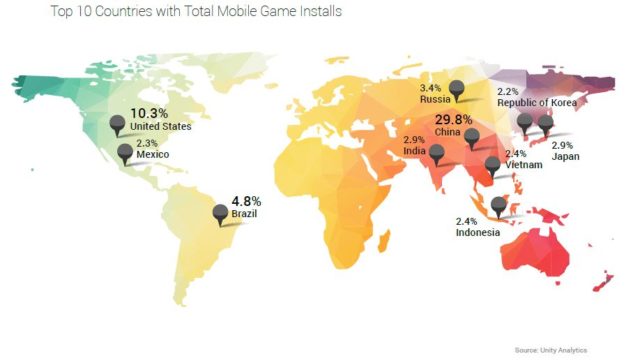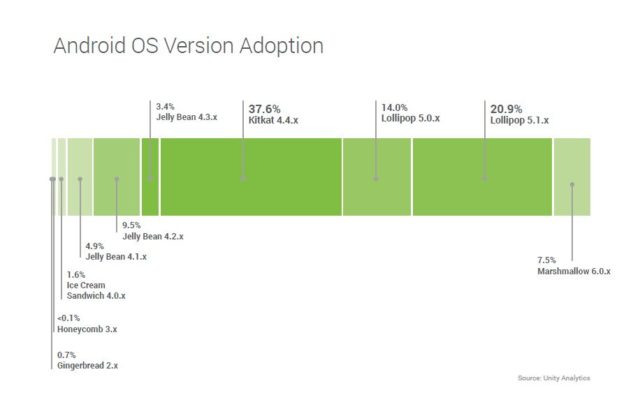One of the most important job functions for marketers at all levels is to keep abreast of the latest industry news, trends and metrics. That knowledge not only informs your overall marketing strategy and day-to-day marketing tactics, it’s vitally important for marketers to share critical knowledge across their company. All kinds of decisions about product development, business development and management depends on this knowledge, and marketing is where most businesses look for that info. Even more important is taking in information from a variety of sources as a way to verify important trends and to look for inconsistencies.
One of the leaders in creating development tools for the games industry is Unity, and its enormous user base of developers provides a broad perspective on what’s happening across the games industry. Its latest report, Games By the Numbers Q2 2016, has plenty of useful information. As the report notes, “With 238,248 made with Unity games generating 4.4 billion installs across 1.7 billion unique devices globally in Q2 2016, Unity is uniquely positioned to help understand trends across the greater mobile games industry.”
The report details the progress that mobile games are making and the current market conditions around the world. The growth in game installs is being led by the BRIC countries: Brazil, Russia, India and China, who collectively accounted for four of the five top countries for global game installs with 41 percent of the total (42 percent of Android game installs).
Android Fragmentation Continues
One of the biggest issues for Android is the severe fragmentation of the user base, both with the incredible range of devices and the variation in Android operating system versions. Those two factors make it difficult for developers to create games that can work seamlessly across the Android market. Worse, trying to test software across a representative sample of Android devices running different versions of the Android OS can be expensive, difficult and time-consuming. So product developers need to know from marketers just what the Android market currently looks like, so that developers can address the minimum number of different devices and OS versions.
The Android OS fragmentation is clearly an issue, with Marshmallow (Android 6.0.x), the latest version of Android OS, only at a 7.5 percent market share. Version adoption is spread, with Kitkat (Android 4.4.x) at 37.6 percent, Lollipop (5.0.x) at 14 percent, and Lollipop (5.1.x) at 20.9 percent. Android’s latest OS, Nougat, is being released now. Unfortunately, it doesn’t look like the Android OS fragmentation issue will get better any time soon. It seems more likely the situation will continue about the same or even worse. In short, Android 5.0 or above covers over 40 percent of devices, and games that work on Android 4.4 or better may capture nearly 80 percent of the market.
The report also noted that while Samsung led the BRIC Android market with 18.1 percent of game installs and 35.1 percent of the overall market. Other top Android phone makers were all Chinese: Xiaomi, VIVO, OPPO, and Huawei. That correlates with other sources, which show that the growth in the mobile phone market is coming from the lower-end and midrange Android phones. These mobile devices have enough horsepower to do a good job playing games, and lower prices that are attracting a broader audience. Although some lower-cost manufacturers are gaining on Samsung, none of the other companies have risen out of the single digits in market share.
The iOS market has a much cleaner situation, with 78 percent of installs occurring under iOS 9. If you include iOS 8.x’s 12.5 percent share, you’ve got over 90 percent of the iOS device market covered. As far as the hardware goes, iPhones are over two-thirds of game installs. The latest versions of the iPhone (the 6 and 6s models) collectively account for over 36 percent of the iPhones out there, or over half of all the iOS devices.

Geographic Trends: Android Vs. iOS
While Android is clearly dominant in terms of sheer numbers across the world, that dominance varies from place-to-place. Some 96 percent of game installs in Indonesia are on Android; both Korea and Brazil have Android game installs at 92 percent of the total. China saw 81.4 percent of its game installs occur on Android, the US saw 68.8 percent of game installs on Android, and Japan saw only 47 percent of game installs on Android. Overall, 82 percent of global game installs occur on Android and only 17 percent on iOS devices.
The best places for iOS software are clearly China, Japan, and the US. Those three nations combined had 60 percent of iOS game installs worldwide. Beyond that, individual countries are responsible for low single-digit amounts of iOS worldwide game installs, with the UK in fourth position and dropping from there.
The leading countries for Android installs are China (with almost 30 percent), the US (with 8.6 percent) and Brazil (with 5.4 percent), trailing off into low single digits from there. Collectively, all the top 10 countries for Android installs were only 63 percent of total Android game installs, while the iOS top ten countries represented over 75 percent of game installs. Android is just more widely spread than iOS, and there’s no sign that will change in the future.
Summary
The mobile game market continues to increase in size, with Unity alone seeing 238,248 mobile games made with Unity generating over 4.4 billion game installs in the second quarter of 2016, reaching over 1.7 billion unique devices. That’s up from first quarter by 4 percent on unique devices, 6 percent on installs, and 8 percent in the new games available.
Unity is probably responsible for at least one-third of all mobile games out there, and perhaps more. These numbers they’ve shared provide significant insight into the market, and marketers should make sure this information gets shared to the people who need to know.

